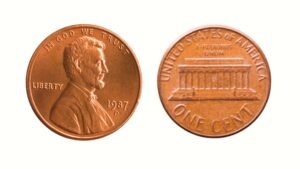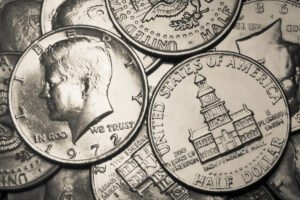A 1936 Buffalo Nickel might seem like just another five-cent piece from the Great Depression era at first glance. But did you know a single 1936 Nickel coin stunned the coin-collecting world when it sold for an astounding $10,575 at a Heritage Auctions sale?
But what makes this particular coin so valuable? And could the 1936 Buffalo Nickel hiding in your change jar also be worth a fortune? This guide will offer you all the answers. From mint errors that create rare varieties to the elusive “3-1/2 Legs” Denver mint issue, learn all the features that make the 1936 Nickel coin a numismatic treasure!
History of the Buffalo Nickels
The first Buffalo Nickel coins, designed by James Earle Fraser, were circulated in 1913. They featured a Native American’s profile on the front and an American bison or buffalo on the reverse. Two types were circulated: Type I with Raised Ground and Type II with Regular Strike.
Within a few years, minor changes were made to the Buffalo Nickel; the word “Liberty” was made more prominent and moved. 1936 is the year in which the highest number of Buffalo nickels were minted.
Finally, due to declining popularity in the coming years, the Jefferson Nickel replaced the Buffalo Nickel in 1938 and is circulated to date!
| 1936 Buffalo Nickel | Key Facts |
| Material (Composition) | Copper (75%) & Nickel (25%) |
| Minting Location | Philadelphia |
| Year of Minting | 1936 |
| Weight | 5 grams (Approx.) |
| Diameter | 21.2 mm |
| Designer | James Earle Fraser |
| Face Value | $0.05 |
| Mint Marks | No Mint Mark (Philadelphia Mint)D (Denver Mint) S (San Francisco Mint) |
| Total Mintage (All Facilities) | 158,745,420 |
Identifying a 1936 Buffalo Nickel (Design & Composition)
The 1936 Buffalo Nickel can be easily identified by its unique American Man and Bison design, suggested by sculptor James Earle Fraser:
1936 Indian Head Nickel Obverse (Heads):
- The large portrait of a Native American man with traditional feathers in his hair (left)
- The word “LIBERTY” on the top-right side
- The mint year “1936” on the bottom left, below the man’s neck
- The letter “F” for designer James Earle Fraser raised below the mint date
1936 Buffalo Nickel Reverse (Tails):
- A huge American bison (a huge buffalo) standing to the left
- The words “FIVE CENTS” below the buffalo
- The country’s name, “UNITED STATES OF AMERICA,” relief carved on the top
- The words “E Pluribus Unum” in very small letters between the word “AMERICA” and the bison’s back
- The mint mark (if any) below the denomination words
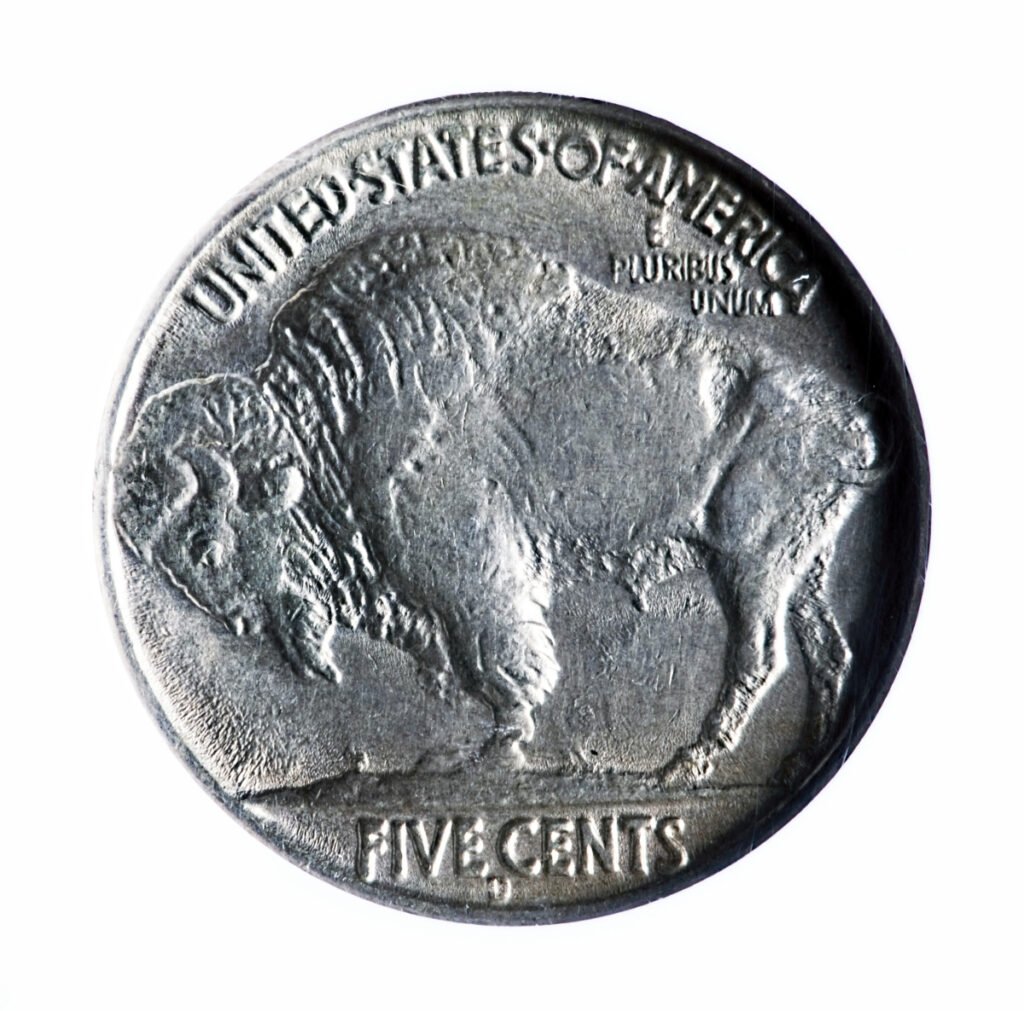
Coin Composition & Dimensions:
The 1936 Indian Head/Buffalo Nickel has the original composition of 75% copper and 25% nickel, which gives the coin its characteristic silver-gray appearance. The coin weighs 5 grams and has a diameter of 21.20 millimeters and a thickness of 1.95 mm, with a plain edge.
4 Factors to Find the Value of the 1936 Buffalo Nickel
To find out how much an old 1936 Indian Head coin is worth, you must analyze the following factors precisely.
1. Mintage & Mint Marks
In 1936, Buffalo Nickels were minted at three locations: Philadelphia, Denver, and San Francisco, with the highest mintage of the Buffalo nickel series, 158,745,420, with as much as 119,001,420 coins struck only in the Philadelphia Mint.
- 1936-p Buffalo Nickel (Philadelphia Mint): All the 119+ million 1936 Buffalo nickels struck in the Philadelphia Mint do not have any mint mark. And due to the highest mintage (among all the mints), these coins are generally worth less, around $300 – $500 in high mint grades, like MS67. The highest mint grade, MS68, examples can sell for up to $6,500.
- 1936-s Buffalo Nickel (San Francisco Mint): The San Francisco Mint struck the least Buffalo nickels in 1936, almost only 15 million. All these coins have an “S” mint mark on the reverse below “FIVE CENTS.” This coin is worth around $4,000 – $6,000+ in the highest mint grade, MS67+. No 1936-s MS68 nickel has been graded as of now.
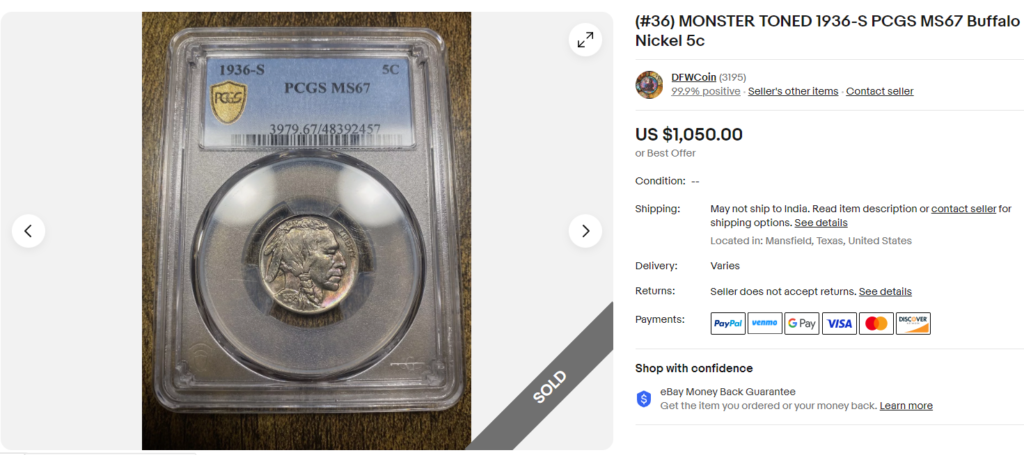
- 1936-d Buffalo Nickel (Denver Mint): The Denver Mint produced over 24 million Buffalo nickels in 1936, all of which bear a “D” mint mark on the reverse, below “FIVE CENTS.” These nickel coins are more valuable than 1936-p nickels, worth around $1,000 for high-grade mint-state examples, like MS67 – MS67+, and $30,000 to $40,000 for rare MS68 examples.
| 1936 Buffalo Nickel Mint Marks | Total Mintage |
| 1936-p Buffalo Nickel (no mint mark) | 119,001,420 |
| 1936-d Buffalo Nickel | 24,814,000 |
| 1936-s Buffalo Nickel | 14,930,000 |
2. Coin Grade & Condition
The final market value of an old 1936 Buffalo Nickel largely depends on its condition. Old coins with faded or flattened details are worth the least despite having errors or rare mint marks.
On the other hand, even less popular varieties can sell for hefty prices if found in extremely good condition and graded with high mint state grades by professional coin grading services like PCGS, NGC, and ANACS.
You can use the following price chart to find an average value for your 1936 nickel coin.
| Coin Grades | 1936-p Nickel Value | 1936-d Nickel Value | 1936-s Nickel Value |
| Poor (0) to Extremely Fine (XF45) | Below $5 | Below $5 | Below $10 |
| Almost Uncirculated (AU50) to Mint State (MS60) | $5 – $15 | $10 – $30 | $10 – $40 |
| Mint State (MS60 – MS66+) | $15 – $270 | $40 – $350 | $50 – $600 |
| Mint State (MS67 onwards) | $520 – $6,500+ (MS68) | $1,000 – $40,000 (MS68) | $4,000 – $6,000+ |
3. Rare Mint Errors in 1936 Buffalo Nickel
A rare minting error on the 1936 Indian Head nickel can greatly impact its worth. As of now, the following valuable 1936 Buffalo nickel errors have been discovered:
1936-D 3 1/2 Legs Error
This is one of the most valuable errors in the 1936 Indian Head Nickel, which has the front leg of the buffalo partially missing. It is only found in 1936-d nickels. One of the highest mint-state examples of 1936-d 3-½ leg error nickel, an MS63 coin sold for almost $20,700, according to PCGS.
Double Die Obverse
This error causes the doubling of letters, numbers, and the American man’s portrait outline on the 1936–p Buffalo Nickel obverse. Depending on the degree of doubling and coin grading, the 1936 DDO nickel coins can be worth around $200 to $3,000+ in the average mint state, with higher prices in high mint state grades, like MS67 or above.

Double Die Reverse
This 1936 error nickel coin features the doubling of letters and numbers on the reverse. In mint state, it can be worth $100 to $1,000, with the highest-grade example, an MS64 1936 5C DDR coin, selling for $1,527 on Heritage Auctions.
Repunched Mint Mark (RPM)
This error occurs when the “d” or “s” mint mark is struck multiple times on the reverse of the 1936 Indian Head nickel. Both 1936-S/S 5C RPM and 1936-D/D %C RPM coins are worth $150 to $1,000 depending on the coin grades. These coins are rarely found in high mint state grades, like this MS67 example that sold for almost $2,000 on eBay.
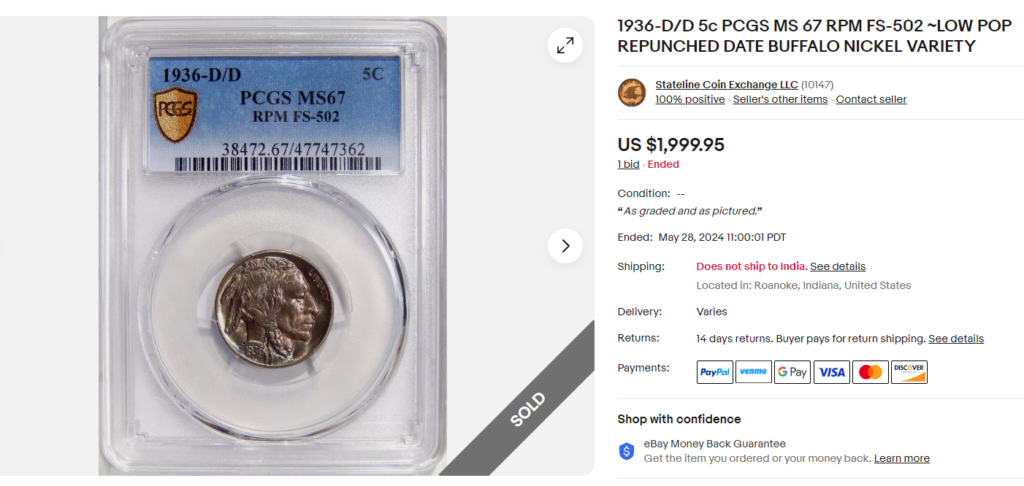
4. 1936 Buffalo Nickel Brilliant/Proof Variety
Apart from the regular strikes, the Philadelphia Mint also struck around 4,420 proof nickel coins in 1936. These coins feature a sharp, mirrored finish with frosted details.
A rare PR68+ graded 1936 5C Brilliant proof coin sold for almost $40,000 on Legend Rare Coin Auctions. MS67 and MS67+ examples are worth around $2,000 to $5,500, like this one I found on eBay that sold for $3,500.

5 Steps to Spot a 1936 Buffalo Nickel Counterfeit
Double-check the following features to distinguish a replica or fake 1936 Buffalo Nickels from authentic ones.
- Weight and Dimensions: A 1936 Indian Head nickel that doesn’t weigh 5 grams or measure 21.20 mm in diameter is fake. Use precise scales to measure both criteria.
- Material Composition: It should be made of 75% copper and 25% nickel and have a consistent silver-gray appearance. A too-shiny or odd tint hints at counterfeits.
- Date and Mint Mark: The mint date should be carved on the front, and the mint marks (If present) should be correctly positioned below “FIVE CENTS” on the reverse. Fake coins may have blurry or misshapen digits or letters.
- Edge Examination: The real 1936 nickels will have a plain edge, not reeded. Also, any seams or file marks on the edge indicate a cast fake.
- Magnetism Test: Like traditional Buffalo nickels, the 1936 nickel is not magnetic due to its copper-nickel composition. So, if your coin reacts to a magnet, it’s counterfeit.
As we saw, the 1936 Buffalo Nickel holds more value than you would have thought. From the commonly circulated examples to the rare mint errors and pristine uncirculated specimens, these coins offer something for collectors at every level.
While not every 1936 nickel will fetch five figures at auction, this guide will help you trace the potential for hidden treasures. The 1937 Buffalo Nickel is another highly collectible nickel worth a BIG fortune. Learn to spot & value them in my detailed guide!
Note: This article is intended for informational, educational, and entertainment purposes only. Some images are illustrative and may not represent actual brands, products, or related entities. All trademarks, product names, brand logos, packaging, and other intellectual property referenced remain the exclusive property of their respective owners. Any brand mentions or references are provided solely for descriptive and educational context and do not imply any formal or commercial association.






